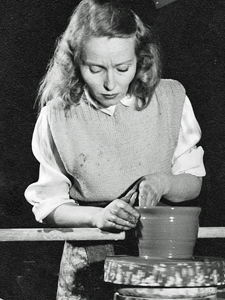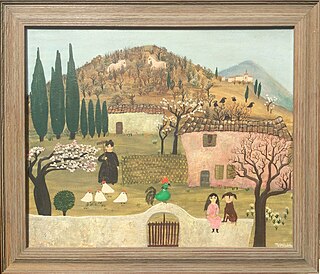
Ossip Zadkine was a Russian-French artist of the School of Paris. He is best known as a sculptor, but also produced paintings and lithographs.

Georg Arthur Jensen was a Danish silversmith and founder of Georg Jensen A/S.

Dame Lucie Rie, was an Austrian-born, independent, British studio potter working in a time when most ceramicists were male. She is known for her extensive technical knowledge, her meticulously detailed experimentation with glazes and with firing and her unusual decorative techniques.

Edith Kiertzner Heath was an American studio potter and founder of Heath Ceramics. The company, well known for its mid-century modern ceramic tableware, including "Heathware," and architectural tiles, is still operating in Sausalito, California, after being founded in 1948.

Eliot Janeway, born Eliot Jacobstein, was an American economist, journalist and author, widely quoted during his lifetime, whose career spanned seven decades. For a time his ideas gained some influence within the administration of President Franklin D. Roosevelt, and he was an informal economic advisor to Lyndon B. Johnson, especially during Johnson's years in Congress, though he broke with Johnson over the economics of the Vietnam War. His eclectic approach focused on the interaction between political pressures, economic policy and market trends. He was at times a vigorous critic of the economic policies of presidents from Franklin D. Roosevelt to Ronald Reagan. His enduring pessimism about US economic prospects earned him the nickname "Calamity Janeway".

Patchin Place is a gated cul-de-sac located off of 10th Street between Greenwich Avenue and the Avenue of the Americas in the Greenwich Village neighborhood of Manhattan, New York City. Its ten 3-story brick row houses, said to have been originally built as housing for the Basque staff of the nearby Brevoort House hotel, have been home to several famous writers, including Theodore Dreiser, E. E. Cummings, John Cowper Powys and Djuna Barnes, making it a stop on Greenwich Village walking tours. Today it is a popular location for psychotherapists' offices.
Harold Ambellan (1912–2006) was an American sculptor. Born in Buffalo, New York and relocated to New York City, Ambellan provided sculpture for New Deal-era projects and served as President of the Sculptors Guild in 1941, prior to his service in the U.S. military. Ambellan exiled himself to France in 1954 because of his political views.

Jens Risom was a Danish American furniture designer. An exemplar of Mid-Century modern design, Risom was one of the first designers to introduce Scandinavian design in the United States.
Edris Eckhardt was an American artist associated with the Cleveland School. She is known for her work in Ceramic art and glass sculpture, her work with the Works Projects Administration's (WPA) Federal Arts Project of Cleveland, and her teaching.

Ceramic art is art made from ceramic materials, including clay. It may take varied forms, including artistic pottery, including tableware, tiles, figurines and other sculpture. As one of the plastic arts, ceramic art is a visual art. While some ceramics are considered fine art, such as pottery or sculpture, most are considered to be decorative, industrial or applied art objects. Ceramic art can be created by one person or by a group, in a pottery or a ceramic factory with a group designing and manufacturing the artware.

Harrison Edward McIntosh was an American ceramic artist. He was an exponent of the Mid-century Modern style of ceramics, featuring simple symmetrical forms. His work has been exhibited in venues in the United States including the Smithsonian and internationally including at the Louvre in France.
Israeli ceramics are ceramics designed either in Mandatory Palestine or Israel from the beginning of the 20th century. In additional to traditional pottery, in Israel there are artists whose works were created in an industrial environment. Until the late 1970s there existed in Israel a local tradition that emphasized the local values of nature as an expression of Zionist identity. From the 1980s artistic expressions that sought to undercut this tradition began to appear in the works of Israeli artists, who combined ceramics with other artistic media and with personal, critical agendas.
Polia Pillin, née Sukonic or Sunockin, was a Polish-American ceramist during the 20th century. Born in Częstochowa, Poland, in 1909, she immigrated to the United States in 1924 and settled in Chicago, Illinois. In 1927, she met and married Ukrainian immigrant William Pillin. They lived near Albuquerque, New Mexico, from 1936-1940; Chicago from 1940-1948; and finally Los Angeles, California, from 1946 until their deaths.
Chris Gustin is an American ceramicist. Gustin models his work on the human form, which is shown through the shape, color, and size of the pieces.
Marie Balian, née Alexanian, was an Armenian artist and ceramic painter, especially known for her distinctive and impressive ceramic tile murals.
Catherine Yarrow was an English artist known for printmaking, painting, ceramics and pottery in a surrealist mode. She studied at the Royal Academy of Dramatic Art, graduating in 1925. The art historian Patricia Allmer has described her as 'one of the international figures of surrealism and its developments in the 1940s.'
Hitomi Hosono is a London-based ceramicist who won the inaugural Perrier-Jouët Arts Salon Prize. She is known for intricate ceramic pieces that are inspired by botanical studies and her memories of the Japanese landscape and the greenery of East London.
Georg Jensen Inc. was a gift and department store known for Scandinavian imports located in midtown Manhattan at 667 Fifth Avenue at 53rd Street from 1935-1968. In 1935, it was founded and managed by Frederik Lunning (1881-1952), re-inventing his original New York store, Georg Jensen Handmade Silver, Inc., founded 1923, at 169 West 57th Street, across from Carnegie Hall. Georg Jensen Inc. was the Lunnings' family business, official importers and vendors of Denmark's Georg Jensen silver. The firm distributed a glossy yearly mail-order catalog illustrated with museum-quality photographs, starting in 1936. The Battle of the Atlantic cut off imports starting in 1939 prompting Jensen's, a major importer from Europe, to cultivate North American artisans, some of whom had emigrated from Europe, and fill their shelves with quality goods: silver jewelry, turned wood, art enamel, tiles and ceramics, lamps. With wartime materials restrictions, Jensen's launched in fall 1942 "The Lunning Collection," a modern furniture collection comprising 21 designs by Jens Risom, executed in-house, along with pieces designed and executed by Otto Christiansen. At Frederik Lunning’s death in 1952, his son Just Lunning managed Georg Jensen Inc. until his sudden death in 1965. Georg Jensen Inc. expanded in 1966, establishing a separate furniture showroom in Manhattan and satellite stores in Manhasset and Scarsdale, New York and in Milburn and Paramus, New Jersey. The Trustees of the Estate of Frederik K Lunning sold all their Jensen stores in 1968, ending the Lunning era of Georg Jensen Inc. In 1978, the last of a series of successor stores and corporations declared bankruptcy.

Tusnelda Sanders was a noted Danish primitivist painter and illustrator whose works were sold both in France and in North American galleries from 1944 until her death. Her graphic illustrations were used in books and posters. From the 1920s until her death, she lived and made art in Cagnes-sur-Mer, the artists' colony on the Cote d’Azur near Nice, France. Her works are signed with the single name, "Tusnelda." Her unofficial name-change to Tusnelda in midlife awaits explanation.
Designed Tiles, a New York City silkscreen studio devoted to decorating and firing ceramic tiles, was established in 1941 by American artist and sculptor Harold Ambellan (1912-2006). In taped interviews of 2005 describing his entire artistic career, Ambellan recounted the beginnings of Designed Tiles. Ambellan operated Designed Tiles from 1941 to 1958 then sold it to Steven and Masha Sklansky who continued to produce decorated tiles until 1978.










